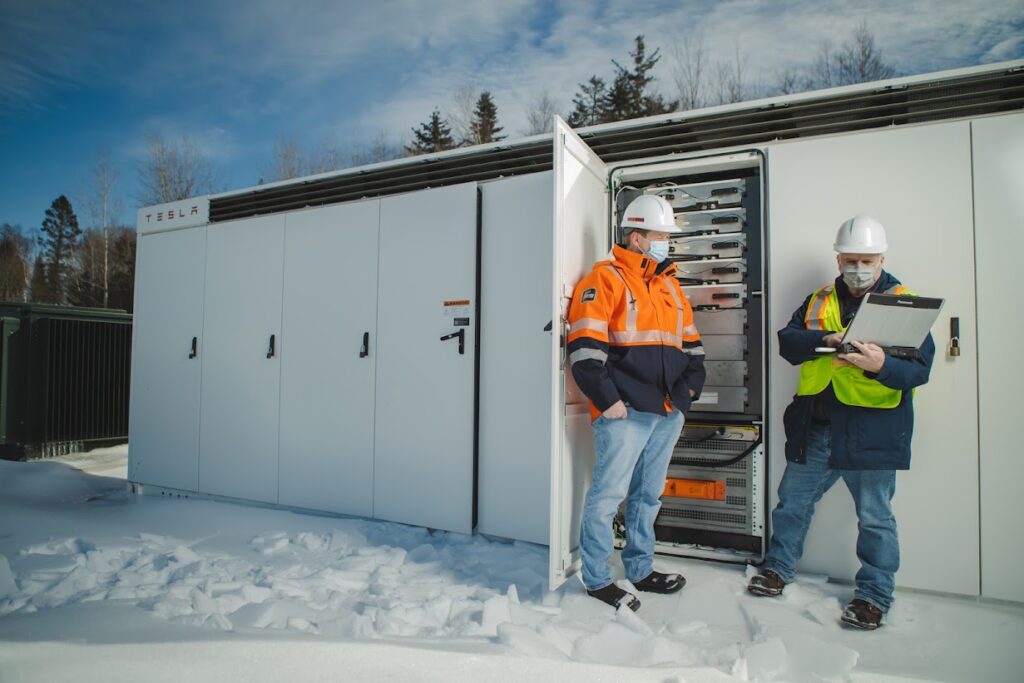In confronting the uncertainty of disruption, Saint John Energy chooses innovation and growth

You never know exactly when disruption will arrive on your doorstep.
When I first joined Saint John Energy in 2016, I was leaving behind more than 15 years with a company in telecommunications – an industry that has undergone massive disruption and reinvention.
Having lived through that upheaval, I was looking forward to another. Some may feel hindered or inconvenienced by disruption; I believe change brings opportunity for those who embrace it.
I also believe the most pressing change we face today is climate change. It is incumbent upon all of us to act responsibly. It is a duty we owe each other to do what we can to mitigate it.
In the energy sector in Canada, we have an opportunity – an opportunity to lead a reinvention that disrupts the march of climate change.
We have an opportunity to champion clean and renewable energy alternatives, to foster innovations that lead to a greener and healthier planet, and to give our customers more control over their energy future.
Saint John Energy is well-placed to be that innovator, removing the friction associated with disruption. Fiscally sound with a loyal and talented workforce, it has both a track record of success and an agility that can be critical for innovation.
Upending longstanding business models
North America’s electricity marketplaces were adapting to new and disruptive technologies, changing regulatory frameworks and shifting consumer expectations. Traditional distribution utilities like Saint John Energy, with a limited scope of services at an at-cost basis in their communities, faced growing challenges with population decline and energy efficiency initiatives pushing down demand.
With technological change and societal expectations upending the long-standing business model, Saint John Energy began to strategically reposition the company to meet these challenges, while still maintaining the traditional services.
We set about drafting a strategy for growth, leaning into five rules I found to be true in the telecom industry:
- Building business cases for as many top ideas as possible.
- Move fast by thinking big, testing small and failing fast.
- Don’t discard plans, even if they aren’t feasible today. Trends and economics change – something first explored years ago might be perfect now.
- You don’t have to reinvent the wheel – leverage collaboration and partnerships as the most impactful innovation can be weaving together ideas that others have proven.
- Have a deep understanding of your existing cost structure so you can prioritize productivity through innovation.
We wanted our strategy to be built on three pillars: innovation, renewable energy and consumer products.
In exploring ideas, we also felt our responsibility to Saint John – not as a collective of customers, but to the community at large. What we came up with should better the city.
Part of that, we knew, would be designing a plan that would ensure our sustainability as a company well into the future – a locally owned company and all the benefits that flow from that.
‘They need not only us to grow, but they need us to be environmentally responsible. And if we can grow through being environmentally responsible, what is better than that?’
And we wanted a strong emphasis on environmental stewardship – an important principle that would later be exemplified when the Canadian Electricity Association recognized Saint John Energy in 2018 as a Sustainable Electric Company, the first such designation in Eastern Canada.
We also knew we wanted the growth strategy to spur job creation for the city and region. It is my strong belief that companies with the ability to grow have a duty to do so – for the prosperity of their people and their communities. A duty to build a stronger future for our children.
They need not only us to grow, but they need us to be environmentally responsible. And if we can grow through being environmentally responsible, what is better than that?
We also knew that while Atlantic Canada has made significant progress reducing greenhouse gas emissions – emissions declined by 22.5 per cent in the region from 2005 to 2018 and 80 per cent of energy generation is non-emitting – more needed to be done.
Doing the right thing
As leaders, we felt a duty to ensure our growth plans were aligned with these goals.
The choices for what to embrace and what to shelve were not easy but we were guided by the principle that you can never go wrong doing the right thing.
That was Saint John Energy’s approach when debating whether we should introduce the Home Heat Saver program. A first for Atlantic Canada, it provides customers access to aerial thermovision heat maps to address heat loss and energy efficiency.
There was no question it would erode our core business of selling electricity – the flip side, though, was this program would benefit customers and the environment.
We went through the same thinking when Saint John Energy evaluated launching a mini-split heat pump rental program several years ago – no question, it would push down demand for electricity. But it improved energy efficiency for our customers, and would have environmental benefits because of that.
Customers are responding. Since launching the heat pump rentals, we have reached 10 per cent penetration in just a few years. Together with our other consumer products, approximately six in 10 customers rent from us – and these revenues now contribute as much to the bottom line as our core business does.
Building a futuristic smart grid

In developing our growth strategy, we leveraged an approach called scenario planning, which I highly recommend for businesses experiencing disruption in their business models.
Among all the ideas that we generated, one stood out as a centrepiece for the future: an enhanced electrical grid powered by advanced artificial intelligence – a futuristic smart grid for Saint John.
Smart grids were not new. We recognized, though, that we didn’t need to be first – we needed to improve on what’s already out there.
We imagined an ambitious approach leveraging AI that could not only manage or shift energy load, but could predict it based on historical patterns and weather forecasts.
A smart grid that could orchestrate an expected proliferation of smart energy devices, manage energy storage options across the city, from customers’ homes to utility-scale batteries. A smart grid would allow for greater overall efficiency.
In the end, we would come up with a plan for a $13.5 million smart grid so advanced in ambition and capability that it attracted significant attention – and investment – from Natural Resources Canada.
‘As a breakthrough project for clean energy for our company, it could not stand alone. We needed to find ways to make it efficient – to get the most out of the power we intend to harness from the wind.’
Another significant advantage of the smart grid is that it will allow us to balance the intermittent nature of renewable energy generation.
That was enticing because one of the other growth ideas we had was one planned out more than a decade earlier but shelved as not viable – a large-scale wind farm for the city.
A drastic drop in the price of wind power generation from the last time we had looked at the idea meant it was not only feasible to bring back onto the drawing board, but it would now save us millions of dollars a year in energy purchasing costs.
What excited us was the scale at which we could adopt this clean energy – the Burchill Wind Project, to be completed in partnership with developer Natural Forces in 2022, will supply enough electricity to power up to 15 per cent of Saint John.
As a breakthrough project for clean energy for our company, it could not stand alone. We needed to find ways to make it efficient – to get the most out of the power we intend to harness from the wind.
First in the world
So a key part of the growth strategy needed to be energy storage – somewhere we could store the wind energy when we didn’t need all Burchill could produce, and draw on it in times of high demand.
An essential part of our initial energy storage ambitions would come in the form of a Tesla Megapack, a utility-scale battery that can store enough energy to power more than 100 homes for two hours.
When installed next to one of our substations in 2019, we became the first in the world to deploy a Megapack. It’s not sitting idle.
The Megapack is an essential part of another important initiative – attacking the environmental and financial costs of peak energy.
In New Brunswick, a province where about 70 per cent of homes rely on electricity for heating, the winter months often push demand requiring our wholesale supplier of electricity to turn on generating plants run by fossil fuels to satisfy the peak.
In fact, generating power at peak can produce as much as twice the carbon emissions as in off-peak times.

Punching well above its weight
The Megapack helps us avoid or curb peaks by allowing us to charge it up in low demand times and discharge it back into the grid in times of high demand. In developing the growth strategy, we knew that one big battery would not suffice. We needed an array of storage options.
In the years to come, we will have thousands across the city – most of them in our customers’ homes. As we roll out our new smart water heaters and smart heat pumps, they become distributed energy resources to help us shift demand for energy.
While customers still retain full control over their energy needs, they can allow us to shift their energy demand, and store or discharge energy in their equipment. Our smart grid – slated to be fully operational in 2022 – will be essential in all this, co-ordinating the energy flow across the system with our control centre staff.
In drawing up the growth strategy, we knew Saint John Energy would be punching well above its weight.
But it was clear to me as I got to know staff across the organization that we had the drive and commitment to pull it off, not to mention a stellar record as one of the highest-rated electrical utility companies in the nation for reliability, trustworthiness and overall customer satisfaction.
We’re well underway in our journey in implementing the growth strategy, and I’m proud of our teams and in the partnerships we’ve forged to make it happen. Knowing that as a small company we did not have all the expertise and knowledge we needed in-house, we reached out to contractors, academia, consultants and suppliers who did, and they have been instrumental in our success.
Anxieties of change
We would not be successful without the support of organizations and collaborators like the Canadian Electricity Association, QUEST, the University of New Brunswick, the New Brunswick Community College, the Canadian Renewable Energy Association, the Smart Energy Consumer Collaborative, Peak Load Management Alliance and the Smart Grid Innovation Network, to name but a few.
That’s not to say that it has been easy. Internally, we have spent a lot of time driving change in an organization that hasn’t seen major transformation in decades.
We all know change is hard. I give full credit to the team at Saint John Energy for seeing the way through the anxieties of change, for allowing themselves to fail along the way, for picking themselves up and moving forward with an unwavering commitment to the organization.
Disruption arrived at their doorstep, and they rose to the occasion. They did it for our customers, for their community, and for a sustainable future.
In 2022, our company will mark 100 years of service to our community. We will reflect on our past accomplishments with great pride. But we will also be able to look ahead to the future with great excitement, knowing we have and will continue to work hard to create the utility of the future for Saint John.
Ryan Mitchell is Vice-President & Chief Development Officer at Saint John Energy, a progressive energy company providing trusted energy solutions to more than 36,000 residential and business customers in Saint John, New Brunswick. Locally owned and operated since 1922, it is one of the highest-rated electrical utilities in Canada for reliability and customer satisfaction. It holds the coveted Sustainable Electricity Company designation and is recognized nationally for innovation. For more information, visit www.sjenergy.com.














